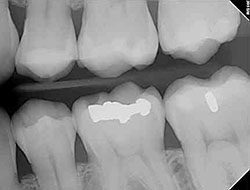Efficient Dental Cleanings and Dental Disease Preventions in Auburn, CA

Regular exams are an important part of maintaining your oral health. During your regular exam, we will:
- Check for any problems that you may not see or feel
- Look for cavities or any other signs of tooth decay
- Inspect your teeth and gums for gingivitis and signs of periodontal disease
- Perform a thorough teeth cleaning
Your regular exam will take about 45 minutes. Each regular exam includes a detailed teeth cleaning, in which we will clean, polish, and rinse your teeth to remove any tartar and plaque that have built up on the tooth’s surface.
Visiting our office every six months gives you the chance to talk to the doctor about any questions you may have about your oral health. Regular exams are offered by appointment only, so please contact our practice today to schedule your next dental exam and teeth cleaning.
The American Dental Association recommends that you visit your dentist every six months to ensure your teeth stay healthy and your smile stays beautiful. Recent studies are showing more and more the correlations between a healthy mouth and better overall health in individuals. The health of your teeth and mouth is vital to the well-being of your entire body. While routine brushing and flossing at home is necessary to keep your smile looking great, visiting your dentist for a comprehensive exam and cleaning is essential.
Prevent the Problem Before It Starts
Did you know that by routinely seeing your dentist for exams and cleanings, you can:
- Prevent tooth decay, gum disease, and bad breath
- Save money by avoiding costly and extensive dental procedures
- Keep your teeth white by reducing staining from food and drinks
- Shorten the time spent in your dentist’s office
Dental Exam
You’ll receive a comprehensive dental exam by the dentist at your initial dental visit. During regular check-up exams, your dentist and hygienist will include the following:
- Examination of diagnostic x-rays: Imaging of the bone and hard tissue in the mouth is essential for detection of decay, tumors, cysts, and bone loss. X-rays also help determine tooth and root positions.
- Gum disease evaluation: Evaluation of the gums and bone around the teeth for any signs of inflammation and periodontal disease.
- Oral cancer screening: Check the soft tissue of the face, neck, lips, tongue, throat, and gums for any signs of oral cancer.
- Check for tooth decay: All tooth surfaces will be checked for decay with special dental instruments.
- Check on existing restorations: Check current fillings, crowns, etc. for decay, cracks, or fractures.
Professional Dental Cleanings
Professional dental cleanings (dental prophylaxis) are usually performed by Registered Dental Hygienists. Your cleaning appointment will include a dental exam and the following:
- Measurements of gum tissue: The dental hygienist will then perform a periodontal exam to make sure your gums adhere tightly to your teeth, and no periodontal disease or bone loss may be occurring.
- Calculus (tartar) removal: Calculus is hardened plaque that is mineralized and is now firmly attached to the tooth surface. Calculus forms above and below the gum line and can only be removed with special dental instruments.
- Plaque removal: Plaque is a sticky, almost invisible film that forms on the teeth. It is a growing colony of living bacteria, food debris, and saliva. The bacteria produce toxins that inflame the gums and the start of periodontal disease.
- Teeth polishing: Removes surface stains and plaque that is not otherwise removed during tooth brushing and cleaning.
- Fluoride Varnish: a highly concentrated form of fluoride is applied to the tooth’s surface. Fluoride is a mineral that can strengthen tooth enamel or outer surface of the tooth. This varnish can help prevent tooth decay, slow it down, or stop it from getting worse.
Contact our office today to schedule an appointment for an exam and cleaning, and maintain a happy and healthy smile.
Using the most advanced dental technology possible is just as important as staying up-to-date on the latest treatment techniques. Because our practice is dedicated to providing you with the safest and most convenient treatment options available, we utilize advanced digital X-ray technology in our office.
Digital X-rays provide several advanced imaging options designed to save time, provide clearer dental photos, and expose patients to less radiation than traditional X-ray technology.
Our practice is focused on making your dental experience as comfortable as possible. At your next appointment, we’ll be happy to answer any questions you may have.


All radiographs (X-rays) are of digital quality. This form of X-ray allows Dr. Friedman and the patient to view the results within seconds of taking the image. Because the digital X-ray exposure is shorter than conventional X-rays, the amount of radiation is reduced by up to 90%. Digital radiography is an advanced technology that speeds up treatment and helps us make the most accurate and efficient diagnosis of your dental condition.
Fluoride is the most effective agent available to help prevent tooth decay. It is a mineral that is naturally present in varying amounts in almost all foods and water supplies. The benefits of fluoride have been well known for over 50 years and are supported by many health and professional organizations.
Fluorine, a natural element in the fluoride compound, has proven to be effective in minimizing childhood cavities and tooth decay. Fluoride is a key ingredient in many popular brands of toothpaste, oral gel, and mouthwash, and can also be found in most community water supplies. Though fluoride is an important part of any good oral care routine, overconsumption can result in a condition known as fluorosis. The pediatric dentist is able to monitor fluoride levels, and check that children are receiving the appropriate amount.
How can fluoride prevent tooth decay?
Fluoride fulfills two important dental functions. First, it helps to staunch mineral loss from tooth enamel, and second, it promotes the remineralization of tooth enamel.
When carbohydrates (sugars) are consumed, oral bacteria feed on them and produce harmful acids. These acids attack tooth enamel – especially in children who take medications or produce less saliva. Repeated acid attacks result in cavities, tooth decay, and childhood periodontal disease. Fluoride protects tooth enamel from acid attacks and reduces the risk of childhood tooth decay.
Fluoride is especially effective when used as part of a good oral hygiene regimen. Reducing the consumption of sugary foods, brushing and flossing regularly, and visiting the pediatric dentist biannually, all supplement the work of fluoride and keep young teeth healthy.
How much fluoride is enough?
Since community water supplies and toothpastes usually contain fluoride, it is essential that children do not ingest too much. For this reason, children under the age of two should use an ADA-approved, non-fluoridated brand of toothpaste. Children between the ages of two and five years old should use a pea-sized amount of ADA-approved fluoridated toothpaste on a clean toothbrush twice each day. They should be encouraged to spit out any extra fluid after brushing. This part might take time, encouragement, and practice.
The amount of fluoride children ingest between the ages of one and four years old determines whether or not fluorosis occurs later. The most common symptom of fluorosis is white specks on the permanent teeth. Children over the age of eight years old are not considered to be at-risk for fluorosis, but should still use an ADA-approved brand of toothpaste.
Does my child need fluoride supplements?
The pediatric dentist is the best person to decide whether a child needs fluoride supplements. First, the dentist will ask questions in order to determine how much fluoride the child is currently receiving, gain a general health history, and evaluate the sugar content in the child’s diet. If a child is not receiving enough fluoride and is determined to be at high-risk for tooth decay, an at-home fluoride supplement may be recommended.
Topical fluoride can also be applied to the tooth enamel quickly and painlessly during a regular office visit. There are many convenient forms of topical fluoride, including foam, liquids, varnishes, and gels. Depending on the age of the child and their willingness to cooperate, topical fluoride can either be held on the teeth for several minutes in specialized trays or painted on with a brush.
Fluoride Treatment
Fluoride is the most effective agent available to help prevent tooth decay. It is a mineral that is naturally present in varying amounts in almost all foods and water supplies. The benefits of fluoride have been well known for over 50 years and are supported by many health and professional organizations.
Fluoride works in two ways:
Topical fluoride – strengthens the teeth once they have erupted by seeping into the outer surface of the tooth enamel, making the teeth more resistant to decay. We gain topical fluoride by using fluoride containing dental products such as toothpaste, mouth rinses, and gels. Dentists and dental hygienists generally recommend that children have a professional application of fluoride twice a year during dental check-ups.
Systemic fluoride – strengthens the teeth that have erupted as well as those that are developing under the gums. We gain systemic fluoride from most foods and our community water supplies. It is also available as a supplement in drop or gel form and can be prescribed by your dentist or physician. Generally, fluoride drops are recommended for infants, and tablets are best suited for children up through the teen years. It is very important to monitor the amounts of fluoride a child ingests. If too much fluoride is consumed while the teeth are developing, a condition called fluorosis (white spots on the teeth) may result.
Although most people receive fluoride from food and water, sometimes it is not enough to help prevent decay. Your dentist or dental hygienist may recommend the use of home and/or professional fluoride treatments for the following reasons:
- Deep pits and fissures on the chewing surfaces of teeth.
- Exposed and sensitive root surfaces.
- Fair to poor oral hygiene habits.
- Frequent sugar and carbohydrate intake.
- Inadequate exposure to fluorides.
- Inadequate saliva flow due to medical conditions, medical treatments or medications.
- Recent history of dental decay.
Remember, fluoride alone will not prevent tooth decay! It is important to brush at least twice a day, floss regularly, eat balanced meals, reduce sugary snacks, and visit your dentist on a regular basis.

Preventive dental care is important throughout your life, no matter your age. By practicing good oral hygiene at home and scheduling regular checkups with your dentist, you can help keep your smile bright and healthy for many years to come. Here are a few simple ways that you can prevent the build-up of plaque and cavities:
- Brush your teeth at least twice a day with a soft-bristled toothbrush. Use fluoride toothpaste to remove food particles and plaque from the tooth surfaces. Also be sure to brush the top surface of your tongue; this will remove any extra plaque-causing food particles, and help keep your breath fresh!
- Clean between your teeth by flossing at least once a day. You can also use a mouthwash to help kill bacteria and freshen your breath. Decay-causing bacteria can linger between teeth where toothbrush bristles can’t reach. Floss and mouthwash will help remove plaque and food particles from between the teeth and under the gum line.
- Eat a balanced diet, and try to avoid extra-sugary treats. Nutritious foods such as raw vegetables, plain yogurt, cheese, or fruit can help keep your smile healthy.
- Remember to schedule regular checkups with your dentist every six months for a professional teeth cleaning.
- Ask your dentist about dental sealants, protective plastic coatings that can be applied to the chewing surfaces of the back teeth where decay often starts.
- If you play sports, be sure to ask your dentist about special mouthguards designed to protect your smile.
- Download Printable Instructions
If it’s been six months since your last dental checkup, then it’s time to contact our practice and schedule your next appointment!

Our office is not only dedicated to your smile, we’re also dedicated to your overall wellness. We take a holistic approach to your dental care, which includes an oral cancer screening as a part of your regular exam. Like many kinds of cancer, oral cancer can be life-threatening if not diagnosed and treated early.
We have the skills and tools to ensure that early signs and symptoms of oral cancer and pre-cancerous conditions are identified. While these symptoms may be caused by other, less serious problems, it is very important to visit our office to rule out the possibility of oral cancer. The most common symptoms of oral cancer include:
- Red or white spots or sores anywhere in the oral cavity
- A sore that bleeds easily or does not heal
- A lump, thickening, or rough spot
- Pain, tenderness, or numbness anywhere in the mouth or on the lips
- Difficulty chewing, swallowing, speaking, or moving the jaw or tongue
Our team is trained in a simple, quick screening that involves an examination of your oral cavity as a whole, and not just your teeth, to detect cancerous and precancerous conditions. Besides a visual examination of your mouth, we will also feel the tissue of your mouth and throat to detect any abnormalities. If we find an area of concern, we may perform a simple test, such as a brush test, which collects cells from a suspicious lesion in the mouth to be sent to a laboratory for analysis. If this test comes back atypical or positive, we may recommend a biopsy.
Aside from receiving an oral cancer screening during your checkup at our office, there are many things you can do to help prevent oral cancer.
- The best way to prevent oral cancer is to avoid all tobacco products and only drink alcohol in moderation.
- Maintain a healthy, balanced diet.
- Limit your exposure to the sun and always wear UV-A/B-blocking, sun-protective lotions on your skin as well as your lips.
- During your next dental appointment, ask your dentist to perform an oral exam. Early detection of oral cancer can improve the chance of successful treatment.
A sealant is a thin, plastic coating applied to the chewing surface of molars, premolars and any deep grooves (called pits and fissures) of teeth. More than 75% of dental decay begins in these deep grooves. Teeth with these conditions are hard to clean and are very susceptible to decay. A sealant protects the tooth by sealing deep grooves, creating a smooth, easy to clean surface.
Sealants can protect teeth from decay for many years, but need to be checked for wear and chipping at regular dental visits.
Reasons for sealants
- Children and teenagers – As soon as the six-year molars (the first permanent back teeth) appear or any time throughout the cavity prone years of 6-16
- Adults – Tooth surfaces without decay that have deep grooves or depressions
- Baby teeth – Occasionally done if teeth have deep grooves or depressions and child is cavity prone
What do sealants involve?
Sealants are easily applied by your dentist or dental hygienist and the process takes only a couple of minutes per tooth.
The teeth to be sealed are thoroughly cleaned and then surrounded with cotton to keep the area dry. A special solution is applied to the enamel surface to help the sealant bond to the teeth. The teeth are then rinsed and dried. Sealant material is carefully painted onto the enamel surface to cover the deep grooves or depressions. Depending on the type of sealant used, the material will either harden automatically or with a special curing light.
Proper home care, a balanced diet, and regular dental visits will aid in the life of your new sealants.
